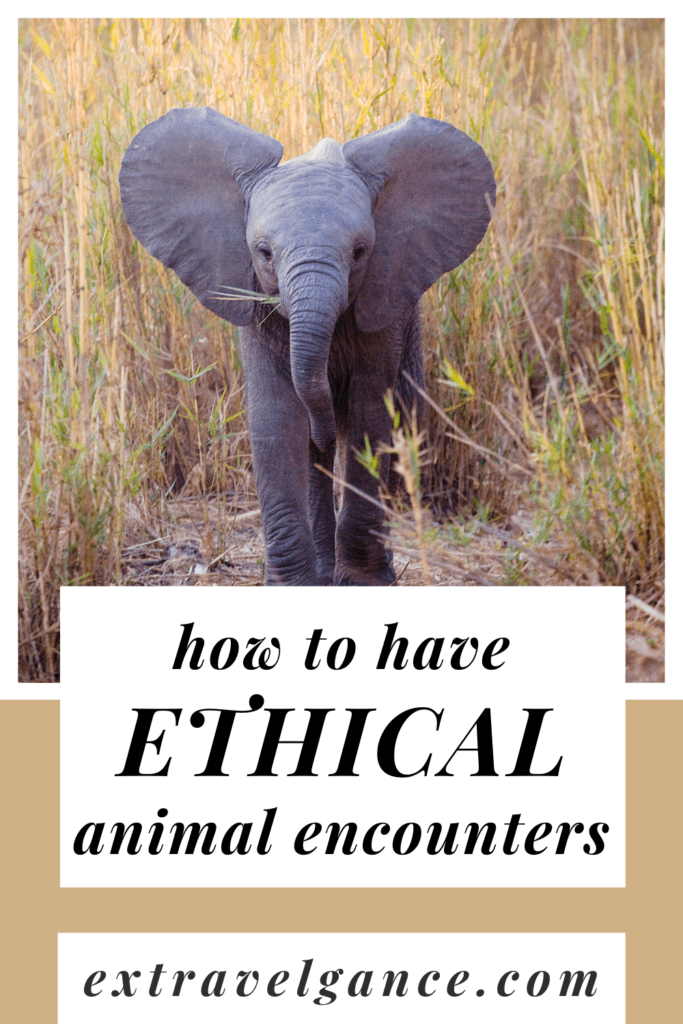
Animal encounters are extremely tempting, but it many cases they are not ethical. Unfortunately, animals may receive poor treatment in order to give you a unique experience and awesome pictures. I’ve fallen into this trap many times, and I want to share what I’ve learned so others can avoid the same temptation.
Elephants
My early tourist animal encounters were definitely not ethical! For example, my brother and I rode on the back of a baby elephant at a zoo. I was probably four or five years old, and all I remember is the stranger sitting in front of me had a runny nose.
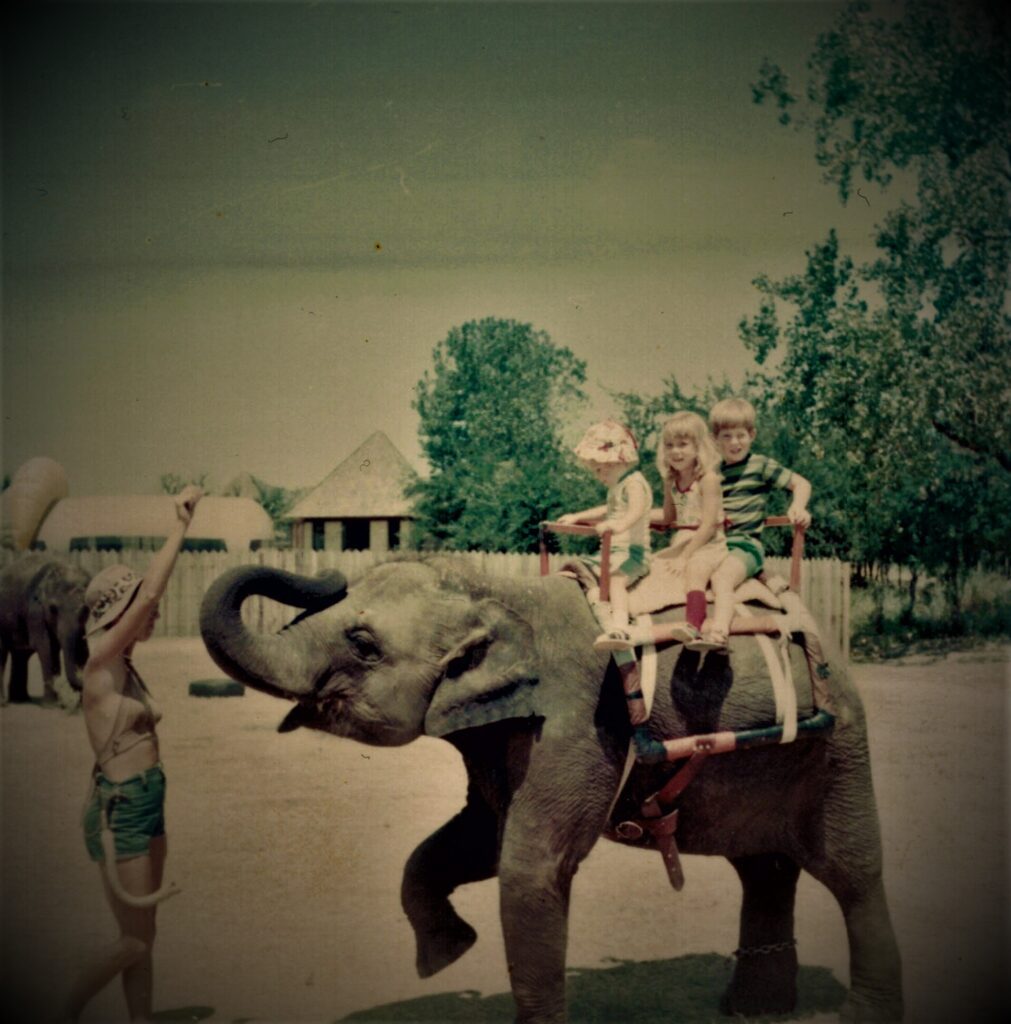
Of course, back in the 1970s I had no idea that this was a bad thing. But now I know that it is for many reasons. Elephants are kept separate from their mothers and suffer abuse when trained to carry people. Also, carrying weight places strain on an elephant’s spine. Having human riders all day every day can cause spinal injuries. Finally, living conditions can vary widely. Some elephants are in chains when not working. In some cases, elephants are alone which is contrary to their need for social interaction with other elephants.
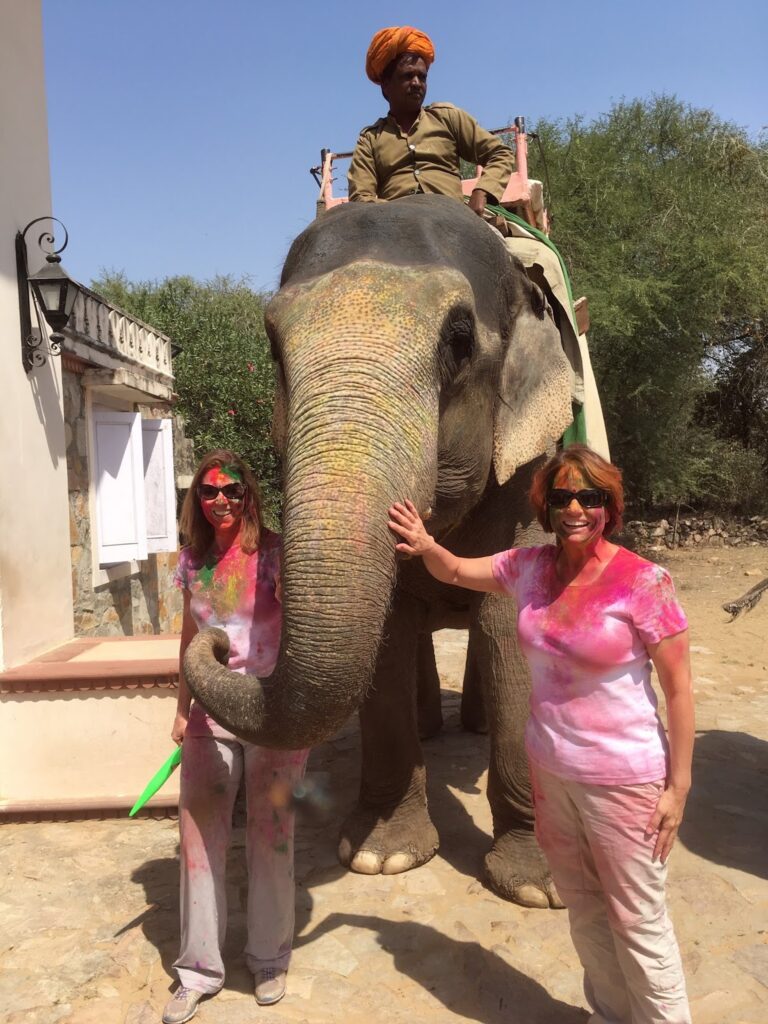
By 2017, I knew that we should not seek out encounters where we got to ride elephants. But here we are in India with an elephant who is clearly carrying a human and in close proximity to us. This was advertised to us as a elephant-friendly encounter. According to World Animal Protection, this is still a no-no.
How to Have Ethical Elephant Encounters

So what should you do regarding elephants in particular? Above is a resource provided by World Animal Protection that will help you choose elephant experiences in your travels.
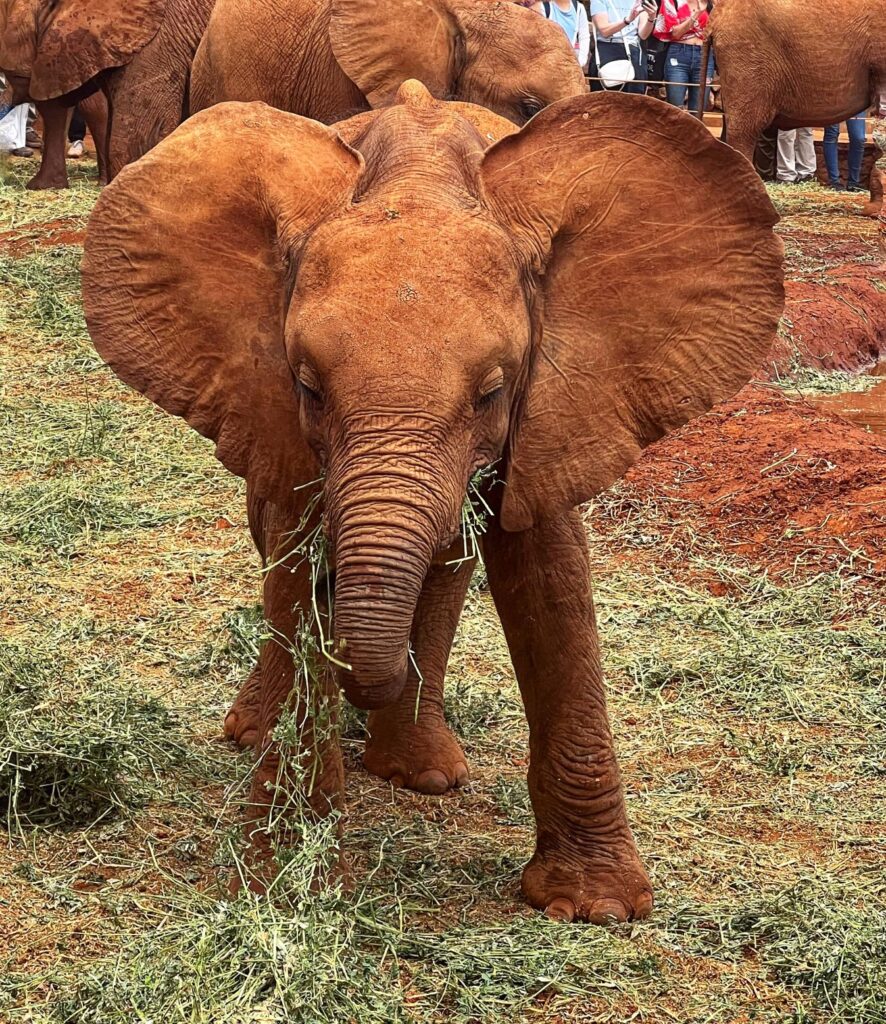
We finally got it right in Kenya! Well, somewhat right. We visited the Sheldrick Elephant Orphanage in Nairobi. This facility cares for orphan baby elephants who lost their mothers to poachers. In the wild, they would die. So the orphanage takes them in, cares for them, and releases them into the Tsavo National Park in Kenya when they grow up where they integrate with the herd.
Why is this particular animal encounter (mostly) ethical? The orphanage is only open to the public one hour each day. That’s it. At all other hours of the day, the elephants are allowed to do whatever elephants do. Only the employees can feed them and elephants aren’t forced to do anything they don’t want to do. One issue is that if a baby elephant did come near, you are allowed to touch it. I refrained – it may not be as much fun just to take pictures of the elephants, but it is far more ethical!
Wild Cats

Honestly, I knew when I was doing this that the wild cats in South Africa weren’t being treated properly. But look at my cool picture! I’m ashamed to admit that this photo was the reason why I was there. And there was something remarkable about petting a cat that could easily kill me. We suspected the big cats we interacted with were drugged, and after-the-fact Googling assures me this is true.

We also happily played with lion cubs. One even bit Amanda, giving her the best story of all stories to tell when talking about her trip to South Africa! I’ve since learned that these cubs were separated from their mother and trained by their handlers to be docile. In the future, the are likely to serve as drugged wild cats for these adult petting zoos.
We thought our tourist dollars were going to support these wild animals. And they are, to some extent. The problem is that these wild cats are subject to terrible treatment in order to be docile enough to interact with humans.
How to Have Ethical Wild Cat Encounters
The only way to have ethical animal encounters with wild cats is to volunteer at a sanctuary. And even then, you need to do your research to make sure the sanctuary is humane. Look for large enclosures that offer plenty of vegetation for an all rescue population. The animals should not be bred in captivity or traded with another facility.
Dolphins

Unfortunately, another activity I’ve done also violates our mission for ethical encounters with animals. On a Caribbean cruise, my family and I went swimming with the dolphins in Mexico. This is advertised as an ethical activity as dolphins are bred in captivity so that scientists could research biological reproduction. Theoretically, the focus of the dolphin swims are on educating humans about dolphins and to raise money for a myriad of environmental and social programs.
Sounds good, right? Well if you dig a bit deeper you will easily uncover that these encounters are not what they seem. Dolphins live in pens in the ocean which are quite large, but they spend most of their time in the smaller pens swimming with humans. Even when they are in the larger pens, dolphins often act aggressively to other dolphins, which is a sign they are under stress. In addition, sometimes these pens are subject to pollution from nearby boat traffic. Dolphins in the wild can escape water pollution, but these dolphins can’t.
How to Have Ethical Dolphin Encounters
So how can you swim with dolphins ethically? The best way is to encounter them in the wild when you are out snorkeling or scuba diving. Dolphins will sometimes interact with humans on their own without coercion. Still, that is pretty rare.
If you must swim with dolphins, make sure that the facility you are using only employs captive born bottlenose dolphins for the experience. Check into the safety records for both the dolphins and the human participants. And make sure the facility cares for the dolphins adequately. Ask if the dolphins are fed high quality fish, allowed to not participate in swims if they demonstrate they don’t want to, work limited hours, and there’s no more than 2 swimmers per dolphin.
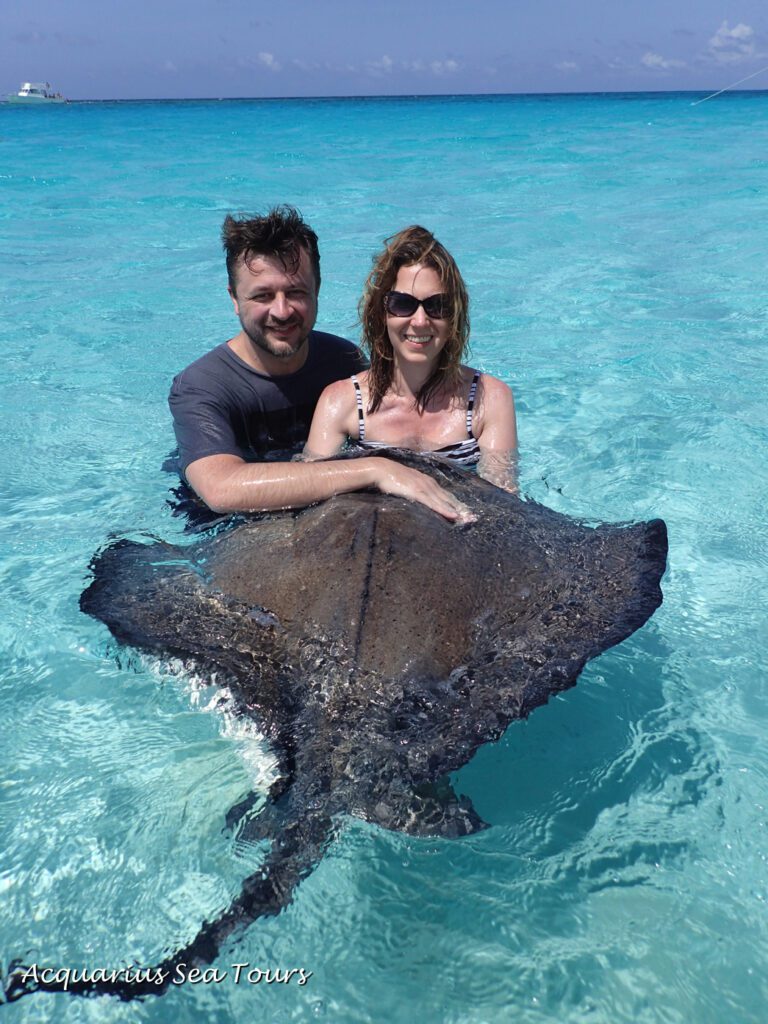
Stingrays
On the same cruise, my family also swam with stingrays in Grand Cayman. I honestly felt like this was OK. They are wild animals who can roam the entire ocean. In Grand Cayman at least, their stingers are not removed. The tour operators feed the stingrays, so they return again and again.
But as I look into this further, I find that these types of group tours disrupts the natural behavior of stingrays. Yes, they willing come for the food, but the food isn’t good for them. Their natural diet consists of worms, crustaceans, and bivalves, not the squid the tour operators feed them. This change in diet impacts their health.
Furthermore, stingrays are nocturnal and usually feed at night while these tours occur during the daytime. It’s also unusual for stingrays to gather in large groups as they are mainly solitary animals. This increases the chance of spreading illness, injuries by boats, and attacks by predators such as hammerhead sharks.
Finally, having a large number of stingrays in one area has a detrimental environmental impact. The worms, crustaceans, and bivalves in the area become depleted. When abundant food is not available, stingrays are more likely to attack each other. There is a higher concentration of stingray waste in the area, which impacts other marine animals. Finally, the area becomes polluted due to the number of tourists and boats.
How to Have Ethical Stingray Encounters
Fortunately, there’s a very simple solution that will allow you to have ethical encounters with this particular animal. Just book a snorkeling excursion that does not go to a place where large numbers of stingrays frequent. There are plenty of other areas where you can find stingrays who are living in a more natural state. Unfortunately, this is likely going to be expensive as you will probably need to book a private boat and tell your tour guide that you want to avoid these group feeding locations. Or you can identify some tour operators who do go to these areas and contact them to see if they have any group snorkeling tours that avoid them. As awareness of these issues rises, there’s sure to be some who will be doing this.

Mountain Gorilla
I’m feeling down about how many times I’ve not had ethical animal encounters, so I’ll end this post with an example of how I got it right! As I described in this post, I trekked mountain gorillas in Uganda. But I have to be honest. I only got it right because the governments of Rwanda, Uganda, and the Democratic Republic of Congo have all taken measures to ensure ethical treatment of this vanishing species.
Each of these countries requires an expensive permit ($400-1,500). The proceeds go to efforts to protect the gorillas and support the local community. Only one group of 8 people or fewer visits a gorilla family each day. Gorillas move from place to place naturally, and trekkers go to where they are. Gorilla minders simply follow them so that they always know where they are. Once trekkers get to the gorillas, they only get to spend one hour with them. During that hour, the trekkers simply observe the gorillas. There’s no touching allowed, and no one makes the gorillas do anything they don’t want to do.
Ensuring Ethical Animal Encounters
I’ll be honest. I have enjoyed my various animal encounters and I’m enamored with the resulting pictures. Unethical tour operators know that there are a ton of people like me out there willing to shell out big bucks for these experiences. They will use flowery language on their websites that make you think you are supporting animal conservation. They will wax poetically about educating humans about these animals and promoting awareness of environmental issues. And sometimes this is true.
My recommendation is to always dig a little deeper. Google is your friend. Type in the activity you are planning and the word humane (i.e. swimming with dolphins humane) and see what pops up. Better yet, type in those same words with the name of your tour operator or the place it visits (i.e. swimming with stingrays Grand Cayman Stingray City humane) for more targeted information.
If you find out something isn’t as humane as it seems, then search for alternatives. There are sure to be some, and I do believe there will be more in the future. Let’s support those efforts so that we can still have our fun while protecting these glorious animals.
What animal encounters have you had?
Hopefully you have been a better friend to wild animals than I have been! Have you found any ethical alternatives that you can recommend? Tell us more below.
.

Pingback: 5 Incredibly Amazing Days of Travel in Nairobi - Extravelgance